Budgeting Report: Financial Analysis and Planning for Rochester Plc
VerifiedAdded on 2021/04/21
|12
|2836
|961
Report
AI Summary
This report provides a comprehensive analysis of budgeting, focusing on its significance in financial planning and control. It begins with an introduction to budgeting, defining its role in organizations like Rochester Plc, a company engaged in manufacturing and selling electronic goods. The report delves into the purpose of budgeting, including its role in providing organizational structure, predicting cash flow, allocating resources efficiently, measuring performance, managing scenarios, and ensuring sound coordination. It then examines the planning and control cycle, outlining the eight phases involved in budget preparation, from setting organizational missions to responding to plan divergences. The report also details the steps involved in budgetary control processes, such as policy formulation, forecast preparation, and budget preparation. Finally, it highlights key budgetary factors, like sales volume and machine capacity, that influence budget preparation. The report emphasizes the importance of early identification of limiting factors and the application of marginal costing where applicable. The report concludes by reinforcing the value of budgeting in reducing expenditure and increasing savings.
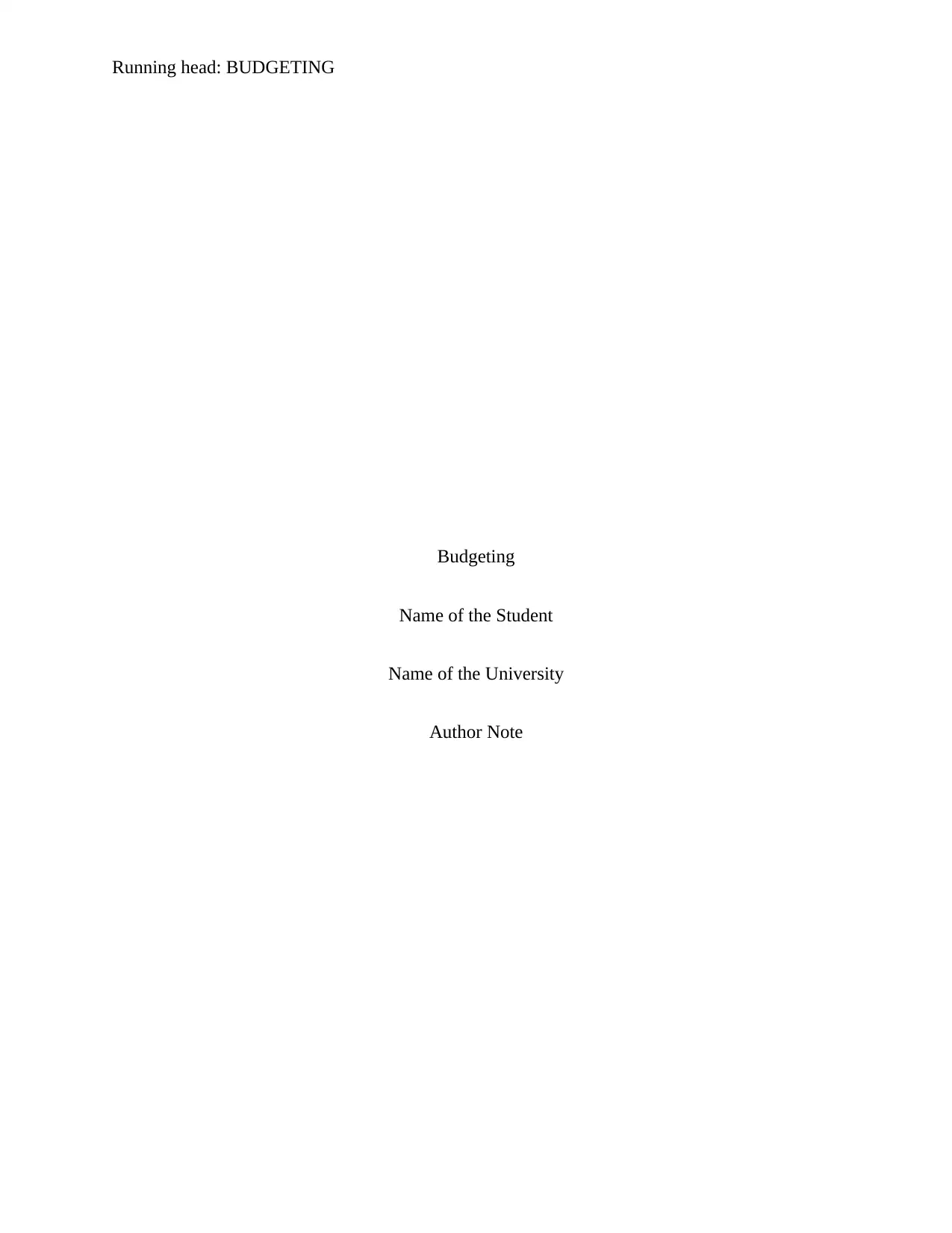
Running head: BUDGETING
Budgeting
Name of the Student
Name of the University
Author Note
Budgeting
Name of the Student
Name of the University
Author Note
Paraphrase This Document
Need a fresh take? Get an instant paraphrase of this document with our AI Paraphraser
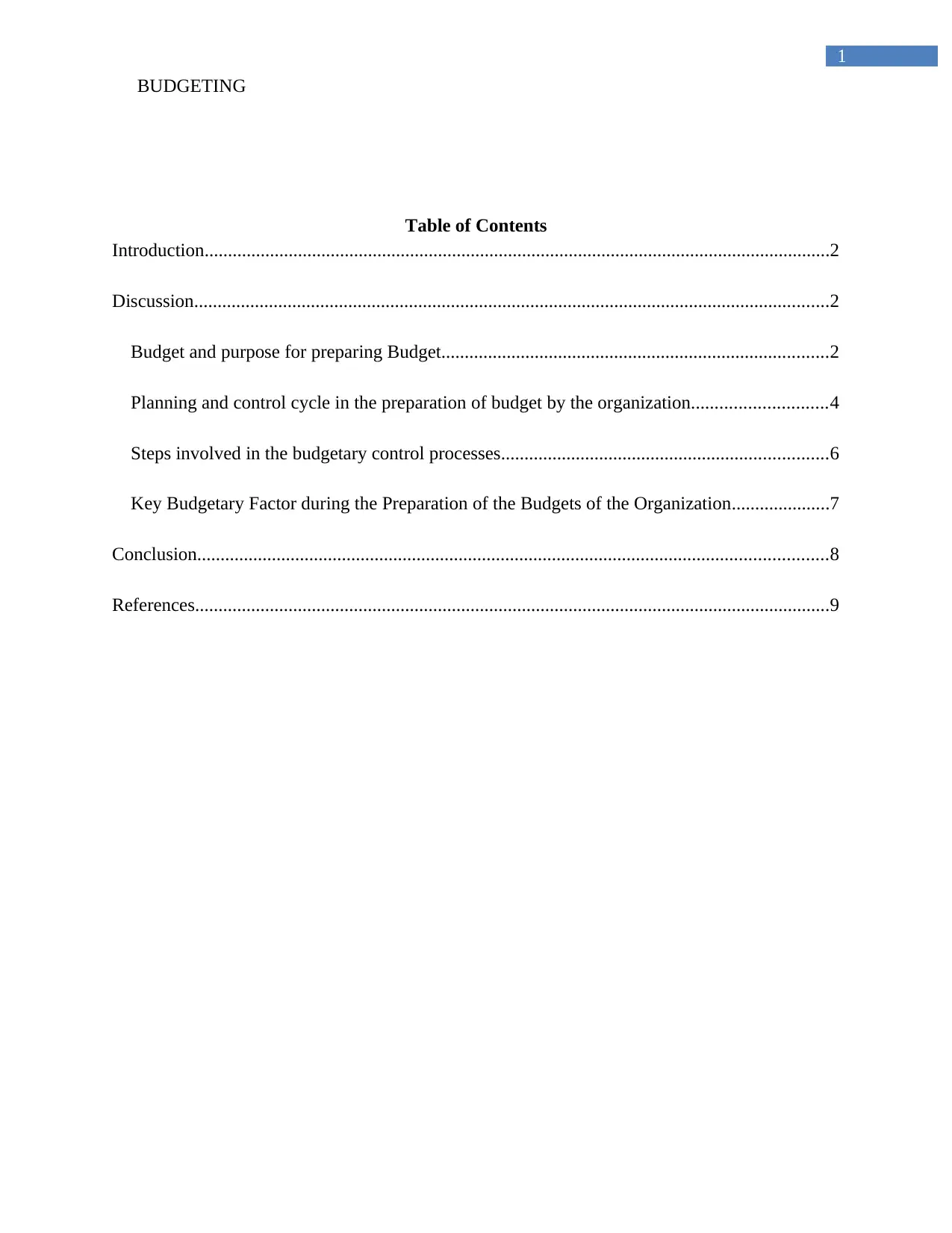
1
BUDGETING
Table of Contents
Introduction......................................................................................................................................2
Discussion........................................................................................................................................2
Budget and purpose for preparing Budget...................................................................................2
Planning and control cycle in the preparation of budget by the organization.............................4
Steps involved in the budgetary control processes......................................................................6
Key Budgetary Factor during the Preparation of the Budgets of the Organization.....................7
Conclusion.......................................................................................................................................8
References........................................................................................................................................9
BUDGETING
Table of Contents
Introduction......................................................................................................................................2
Discussion........................................................................................................................................2
Budget and purpose for preparing Budget...................................................................................2
Planning and control cycle in the preparation of budget by the organization.............................4
Steps involved in the budgetary control processes......................................................................6
Key Budgetary Factor during the Preparation of the Budgets of the Organization.....................7
Conclusion.......................................................................................................................................8
References........................................................................................................................................9
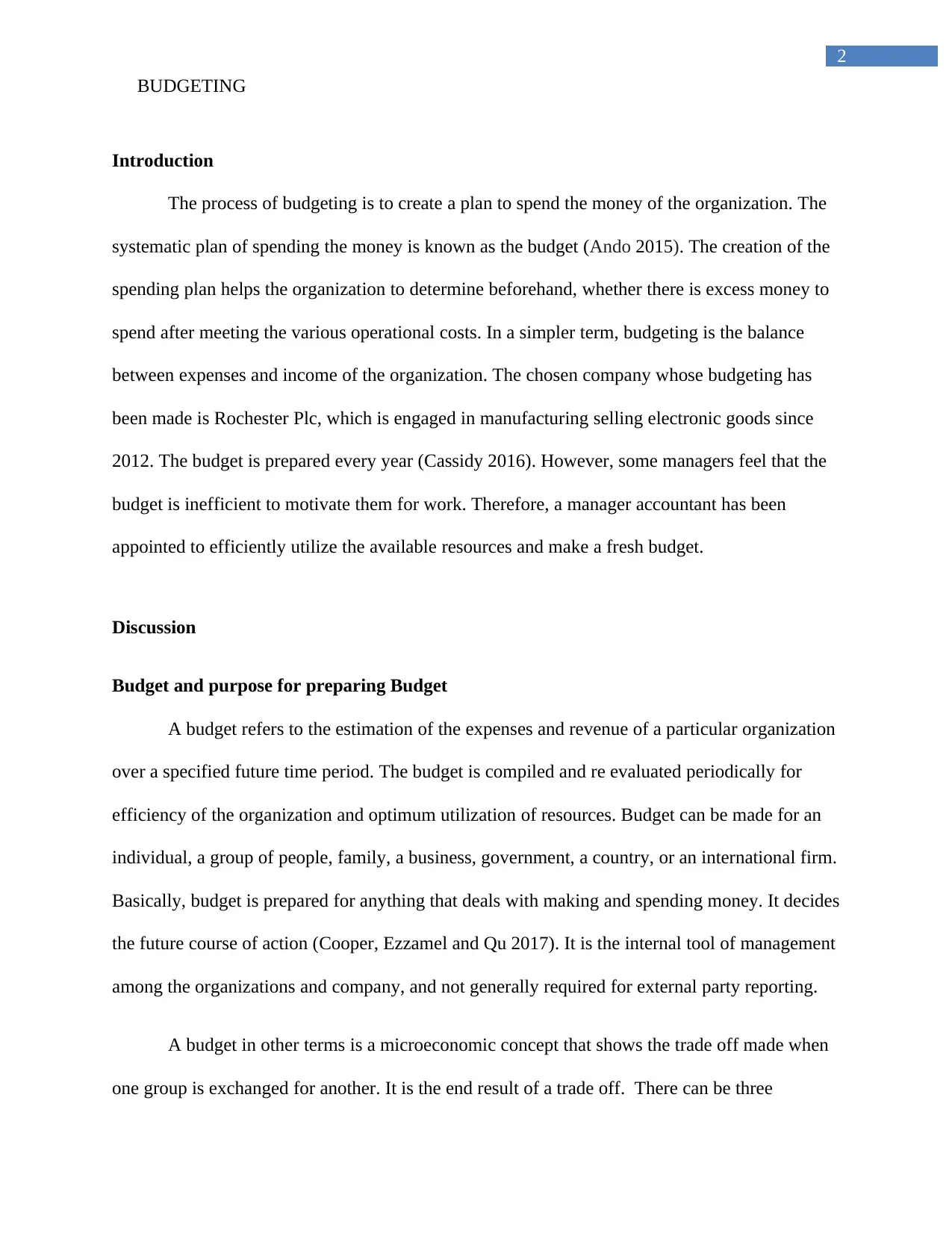
2
BUDGETING
Introduction
The process of budgeting is to create a plan to spend the money of the organization. The
systematic plan of spending the money is known as the budget (Ando 2015). The creation of the
spending plan helps the organization to determine beforehand, whether there is excess money to
spend after meeting the various operational costs. In a simpler term, budgeting is the balance
between expenses and income of the organization. The chosen company whose budgeting has
been made is Rochester Plc, which is engaged in manufacturing selling electronic goods since
2012. The budget is prepared every year (Cassidy 2016). However, some managers feel that the
budget is inefficient to motivate them for work. Therefore, a manager accountant has been
appointed to efficiently utilize the available resources and make a fresh budget.
Discussion
Budget and purpose for preparing Budget
A budget refers to the estimation of the expenses and revenue of a particular organization
over a specified future time period. The budget is compiled and re evaluated periodically for
efficiency of the organization and optimum utilization of resources. Budget can be made for an
individual, a group of people, family, a business, government, a country, or an international firm.
Basically, budget is prepared for anything that deals with making and spending money. It decides
the future course of action (Cooper, Ezzamel and Qu 2017). It is the internal tool of management
among the organizations and company, and not generally required for external party reporting.
A budget in other terms is a microeconomic concept that shows the trade off made when
one group is exchanged for another. It is the end result of a trade off. There can be three
BUDGETING
Introduction
The process of budgeting is to create a plan to spend the money of the organization. The
systematic plan of spending the money is known as the budget (Ando 2015). The creation of the
spending plan helps the organization to determine beforehand, whether there is excess money to
spend after meeting the various operational costs. In a simpler term, budgeting is the balance
between expenses and income of the organization. The chosen company whose budgeting has
been made is Rochester Plc, which is engaged in manufacturing selling electronic goods since
2012. The budget is prepared every year (Cassidy 2016). However, some managers feel that the
budget is inefficient to motivate them for work. Therefore, a manager accountant has been
appointed to efficiently utilize the available resources and make a fresh budget.
Discussion
Budget and purpose for preparing Budget
A budget refers to the estimation of the expenses and revenue of a particular organization
over a specified future time period. The budget is compiled and re evaluated periodically for
efficiency of the organization and optimum utilization of resources. Budget can be made for an
individual, a group of people, family, a business, government, a country, or an international firm.
Basically, budget is prepared for anything that deals with making and spending money. It decides
the future course of action (Cooper, Ezzamel and Qu 2017). It is the internal tool of management
among the organizations and company, and not generally required for external party reporting.
A budget in other terms is a microeconomic concept that shows the trade off made when
one group is exchanged for another. It is the end result of a trade off. There can be three
⊘ This is a preview!⊘
Do you want full access?
Subscribe today to unlock all pages.

Trusted by 1+ million students worldwide
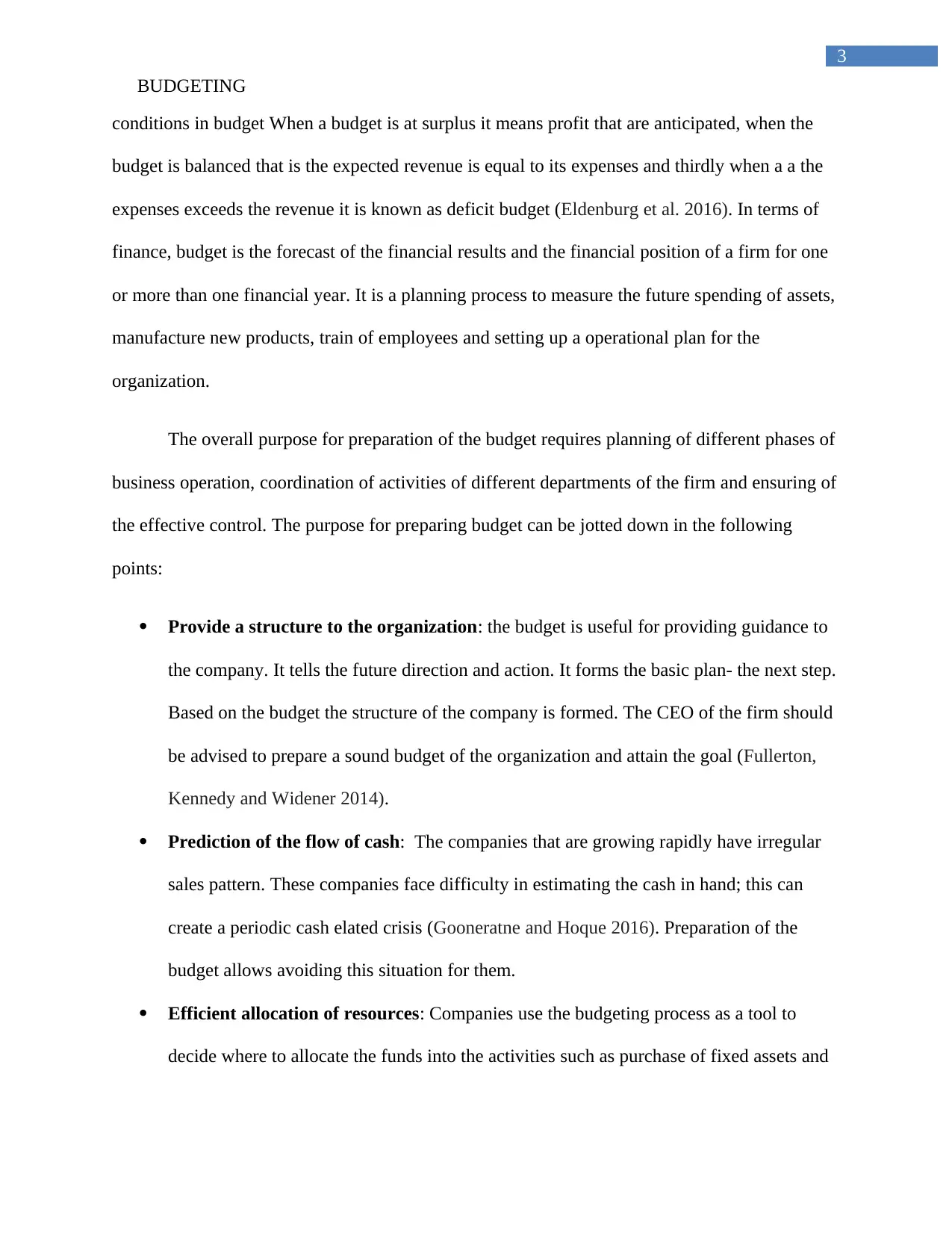
3
BUDGETING
conditions in budget When a budget is at surplus it means profit that are anticipated, when the
budget is balanced that is the expected revenue is equal to its expenses and thirdly when a a the
expenses exceeds the revenue it is known as deficit budget (Eldenburg et al. 2016). In terms of
finance, budget is the forecast of the financial results and the financial position of a firm for one
or more than one financial year. It is a planning process to measure the future spending of assets,
manufacture new products, train of employees and setting up a operational plan for the
organization.
The overall purpose for preparation of the budget requires planning of different phases of
business operation, coordination of activities of different departments of the firm and ensuring of
the effective control. The purpose for preparing budget can be jotted down in the following
points:
Provide a structure to the organization: the budget is useful for providing guidance to
the company. It tells the future direction and action. It forms the basic plan- the next step.
Based on the budget the structure of the company is formed. The CEO of the firm should
be advised to prepare a sound budget of the organization and attain the goal (Fullerton,
Kennedy and Widener 2014).
Prediction of the flow of cash: The companies that are growing rapidly have irregular
sales pattern. These companies face difficulty in estimating the cash in hand; this can
create a periodic cash elated crisis (Gooneratne and Hoque 2016). Preparation of the
budget allows avoiding this situation for them.
Efficient allocation of resources: Companies use the budgeting process as a tool to
decide where to allocate the funds into the activities such as purchase of fixed assets and
BUDGETING
conditions in budget When a budget is at surplus it means profit that are anticipated, when the
budget is balanced that is the expected revenue is equal to its expenses and thirdly when a a the
expenses exceeds the revenue it is known as deficit budget (Eldenburg et al. 2016). In terms of
finance, budget is the forecast of the financial results and the financial position of a firm for one
or more than one financial year. It is a planning process to measure the future spending of assets,
manufacture new products, train of employees and setting up a operational plan for the
organization.
The overall purpose for preparation of the budget requires planning of different phases of
business operation, coordination of activities of different departments of the firm and ensuring of
the effective control. The purpose for preparing budget can be jotted down in the following
points:
Provide a structure to the organization: the budget is useful for providing guidance to
the company. It tells the future direction and action. It forms the basic plan- the next step.
Based on the budget the structure of the company is formed. The CEO of the firm should
be advised to prepare a sound budget of the organization and attain the goal (Fullerton,
Kennedy and Widener 2014).
Prediction of the flow of cash: The companies that are growing rapidly have irregular
sales pattern. These companies face difficulty in estimating the cash in hand; this can
create a periodic cash elated crisis (Gooneratne and Hoque 2016). Preparation of the
budget allows avoiding this situation for them.
Efficient allocation of resources: Companies use the budgeting process as a tool to
decide where to allocate the funds into the activities such as purchase of fixed assets and
Paraphrase This Document
Need a fresh take? Get an instant paraphrase of this document with our AI Paraphraser
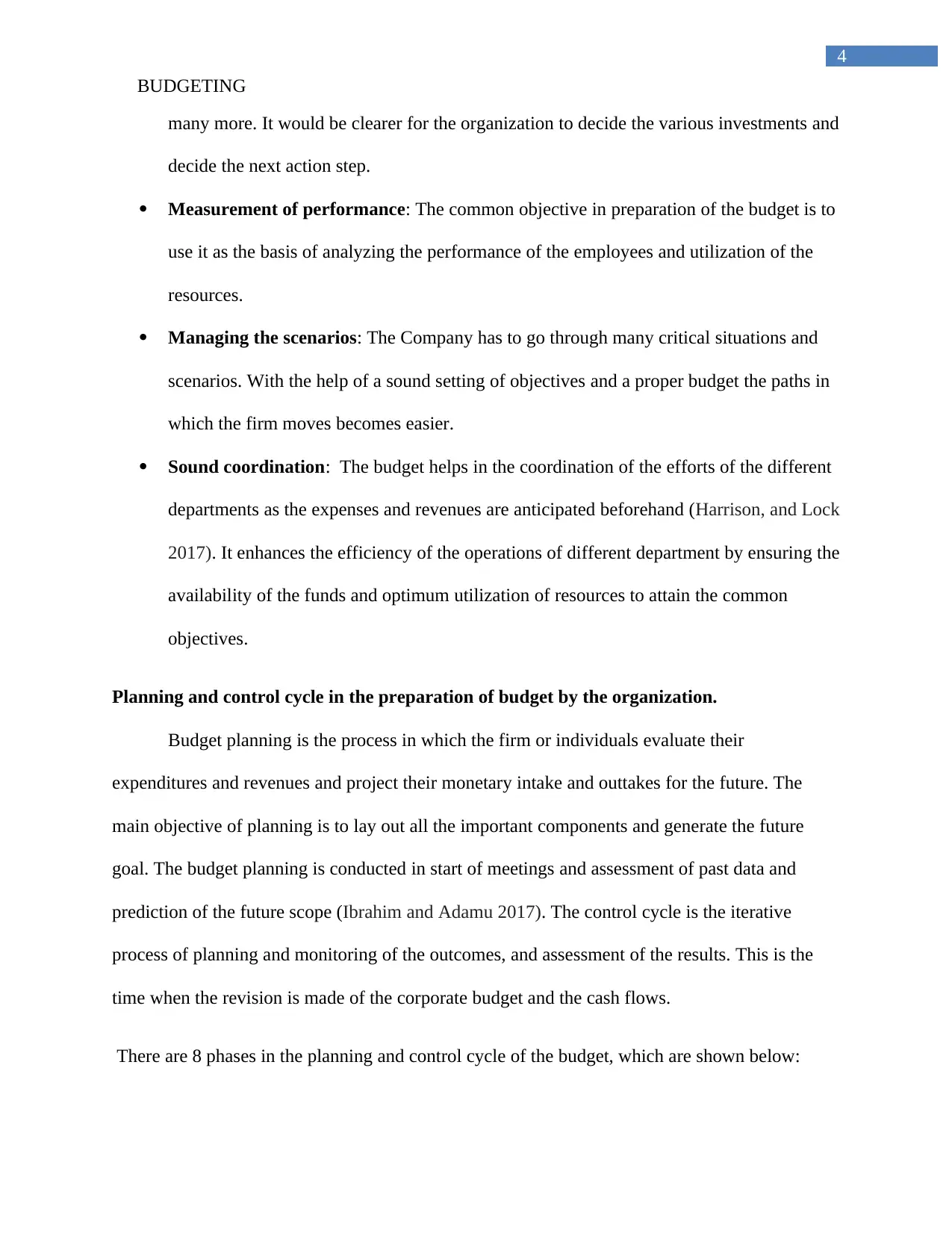
4
BUDGETING
many more. It would be clearer for the organization to decide the various investments and
decide the next action step.
Measurement of performance: The common objective in preparation of the budget is to
use it as the basis of analyzing the performance of the employees and utilization of the
resources.
Managing the scenarios: The Company has to go through many critical situations and
scenarios. With the help of a sound setting of objectives and a proper budget the paths in
which the firm moves becomes easier.
Sound coordination: The budget helps in the coordination of the efforts of the different
departments as the expenses and revenues are anticipated beforehand (Harrison, and Lock
2017). It enhances the efficiency of the operations of different department by ensuring the
availability of the funds and optimum utilization of resources to attain the common
objectives.
Planning and control cycle in the preparation of budget by the organization.
Budget planning is the process in which the firm or individuals evaluate their
expenditures and revenues and project their monetary intake and outtakes for the future. The
main objective of planning is to lay out all the important components and generate the future
goal. The budget planning is conducted in start of meetings and assessment of past data and
prediction of the future scope (Ibrahim and Adamu 2017). The control cycle is the iterative
process of planning and monitoring of the outcomes, and assessment of the results. This is the
time when the revision is made of the corporate budget and the cash flows.
There are 8 phases in the planning and control cycle of the budget, which are shown below:
BUDGETING
many more. It would be clearer for the organization to decide the various investments and
decide the next action step.
Measurement of performance: The common objective in preparation of the budget is to
use it as the basis of analyzing the performance of the employees and utilization of the
resources.
Managing the scenarios: The Company has to go through many critical situations and
scenarios. With the help of a sound setting of objectives and a proper budget the paths in
which the firm moves becomes easier.
Sound coordination: The budget helps in the coordination of the efforts of the different
departments as the expenses and revenues are anticipated beforehand (Harrison, and Lock
2017). It enhances the efficiency of the operations of different department by ensuring the
availability of the funds and optimum utilization of resources to attain the common
objectives.
Planning and control cycle in the preparation of budget by the organization.
Budget planning is the process in which the firm or individuals evaluate their
expenditures and revenues and project their monetary intake and outtakes for the future. The
main objective of planning is to lay out all the important components and generate the future
goal. The budget planning is conducted in start of meetings and assessment of past data and
prediction of the future scope (Ibrahim and Adamu 2017). The control cycle is the iterative
process of planning and monitoring of the outcomes, and assessment of the results. This is the
time when the revision is made of the corporate budget and the cash flows.
There are 8 phases in the planning and control cycle of the budget, which are shown below:
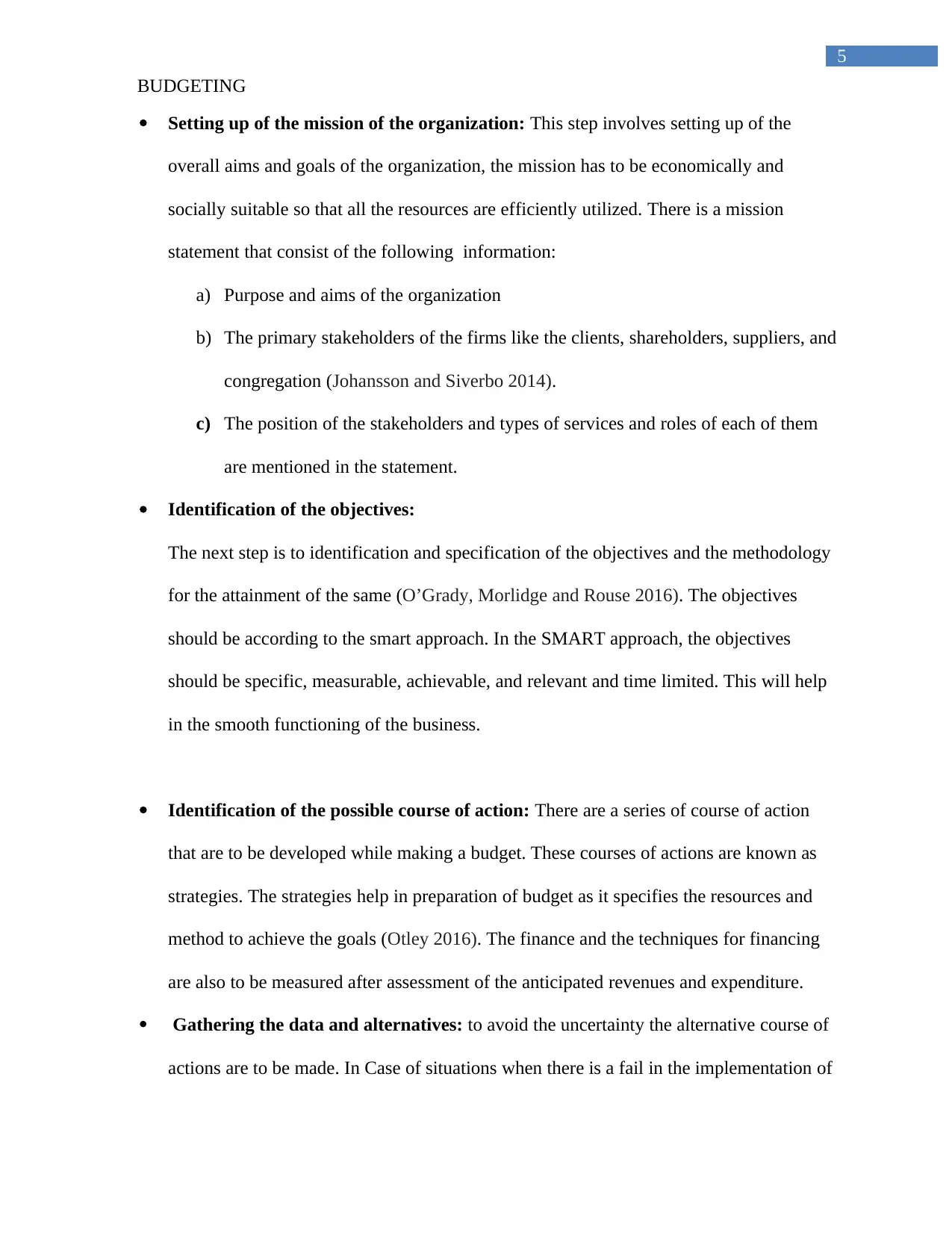
5
BUDGETING
Setting up of the mission of the organization: This step involves setting up of the
overall aims and goals of the organization, the mission has to be economically and
socially suitable so that all the resources are efficiently utilized. There is a mission
statement that consist of the following information:
a) Purpose and aims of the organization
b) The primary stakeholders of the firms like the clients, shareholders, suppliers, and
congregation (Johansson and Siverbo 2014).
c) The position of the stakeholders and types of services and roles of each of them
are mentioned in the statement.
Identification of the objectives:
The next step is to identification and specification of the objectives and the methodology
for the attainment of the same (O’Grady, Morlidge and Rouse 2016). The objectives
should be according to the smart approach. In the SMART approach, the objectives
should be specific, measurable, achievable, and relevant and time limited. This will help
in the smooth functioning of the business.
Identification of the possible course of action: There are a series of course of action
that are to be developed while making a budget. These courses of actions are known as
strategies. The strategies help in preparation of budget as it specifies the resources and
method to achieve the goals (Otley 2016). The finance and the techniques for financing
are also to be measured after assessment of the anticipated revenues and expenditure.
Gathering the data and alternatives: to avoid the uncertainty the alternative course of
actions are to be made. In Case of situations when there is a fail in the implementation of
BUDGETING
Setting up of the mission of the organization: This step involves setting up of the
overall aims and goals of the organization, the mission has to be economically and
socially suitable so that all the resources are efficiently utilized. There is a mission
statement that consist of the following information:
a) Purpose and aims of the organization
b) The primary stakeholders of the firms like the clients, shareholders, suppliers, and
congregation (Johansson and Siverbo 2014).
c) The position of the stakeholders and types of services and roles of each of them
are mentioned in the statement.
Identification of the objectives:
The next step is to identification and specification of the objectives and the methodology
for the attainment of the same (O’Grady, Morlidge and Rouse 2016). The objectives
should be according to the smart approach. In the SMART approach, the objectives
should be specific, measurable, achievable, and relevant and time limited. This will help
in the smooth functioning of the business.
Identification of the possible course of action: There are a series of course of action
that are to be developed while making a budget. These courses of actions are known as
strategies. The strategies help in preparation of budget as it specifies the resources and
method to achieve the goals (Otley 2016). The finance and the techniques for financing
are also to be measured after assessment of the anticipated revenues and expenditure.
Gathering the data and alternatives: to avoid the uncertainty the alternative course of
actions are to be made. In Case of situations when there is a fail in the implementation of
⊘ This is a preview!⊘
Do you want full access?
Subscribe today to unlock all pages.

Trusted by 1+ million students worldwide
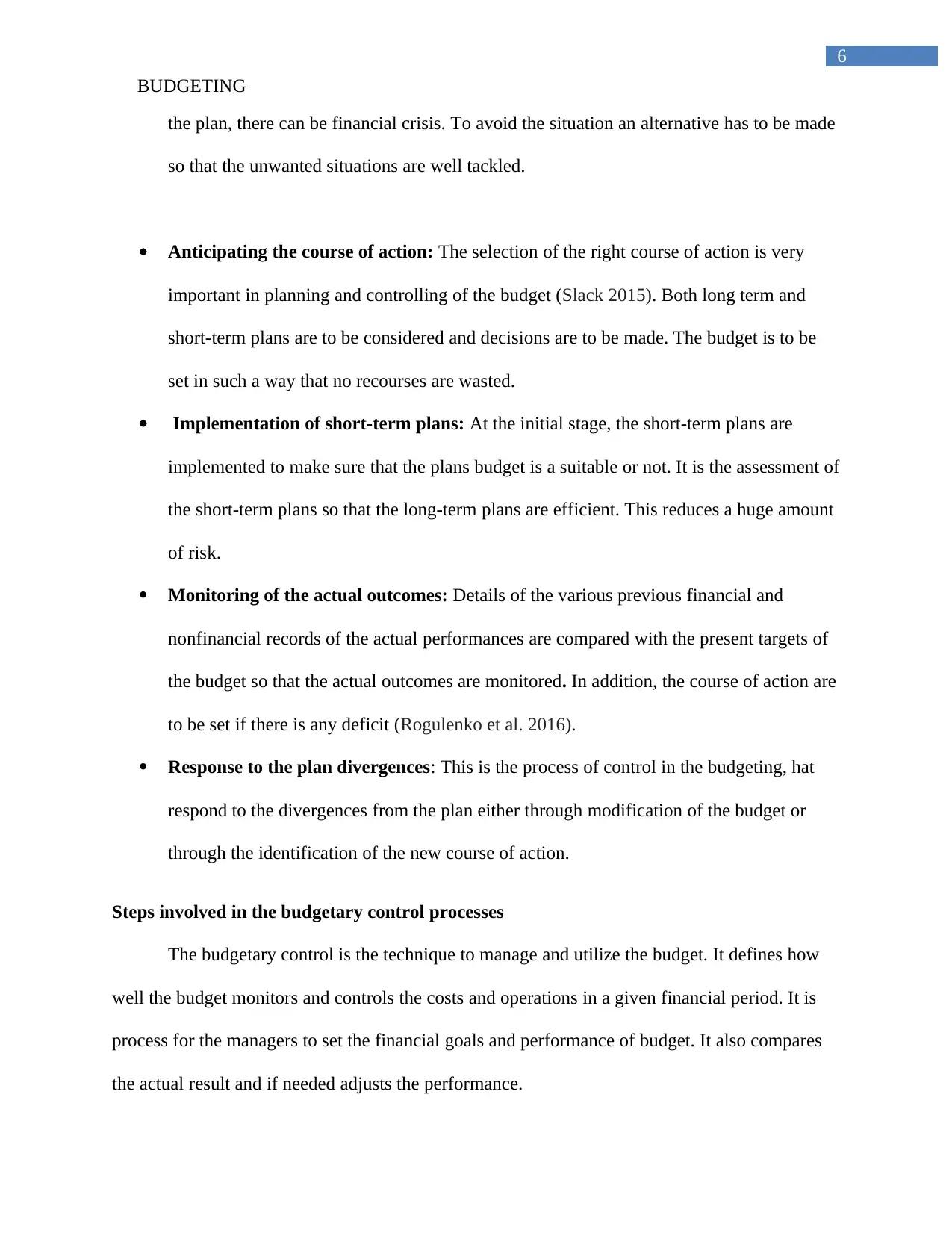
6
BUDGETING
the plan, there can be financial crisis. To avoid the situation an alternative has to be made
so that the unwanted situations are well tackled.
Anticipating the course of action: The selection of the right course of action is very
important in planning and controlling of the budget (Slack 2015). Both long term and
short-term plans are to be considered and decisions are to be made. The budget is to be
set in such a way that no recourses are wasted.
Implementation of short-term plans: At the initial stage, the short-term plans are
implemented to make sure that the plans budget is a suitable or not. It is the assessment of
the short-term plans so that the long-term plans are efficient. This reduces a huge amount
of risk.
Monitoring of the actual outcomes: Details of the various previous financial and
nonfinancial records of the actual performances are compared with the present targets of
the budget so that the actual outcomes are monitored. In addition, the course of action are
to be set if there is any deficit (Rogulenko et al. 2016).
Response to the plan divergences: This is the process of control in the budgeting, hat
respond to the divergences from the plan either through modification of the budget or
through the identification of the new course of action.
Steps involved in the budgetary control processes
The budgetary control is the technique to manage and utilize the budget. It defines how
well the budget monitors and controls the costs and operations in a given financial period. It is
process for the managers to set the financial goals and performance of budget. It also compares
the actual result and if needed adjusts the performance.
BUDGETING
the plan, there can be financial crisis. To avoid the situation an alternative has to be made
so that the unwanted situations are well tackled.
Anticipating the course of action: The selection of the right course of action is very
important in planning and controlling of the budget (Slack 2015). Both long term and
short-term plans are to be considered and decisions are to be made. The budget is to be
set in such a way that no recourses are wasted.
Implementation of short-term plans: At the initial stage, the short-term plans are
implemented to make sure that the plans budget is a suitable or not. It is the assessment of
the short-term plans so that the long-term plans are efficient. This reduces a huge amount
of risk.
Monitoring of the actual outcomes: Details of the various previous financial and
nonfinancial records of the actual performances are compared with the present targets of
the budget so that the actual outcomes are monitored. In addition, the course of action are
to be set if there is any deficit (Rogulenko et al. 2016).
Response to the plan divergences: This is the process of control in the budgeting, hat
respond to the divergences from the plan either through modification of the budget or
through the identification of the new course of action.
Steps involved in the budgetary control processes
The budgetary control is the technique to manage and utilize the budget. It defines how
well the budget monitors and controls the costs and operations in a given financial period. It is
process for the managers to set the financial goals and performance of budget. It also compares
the actual result and if needed adjusts the performance.
Paraphrase This Document
Need a fresh take? Get an instant paraphrase of this document with our AI Paraphraser
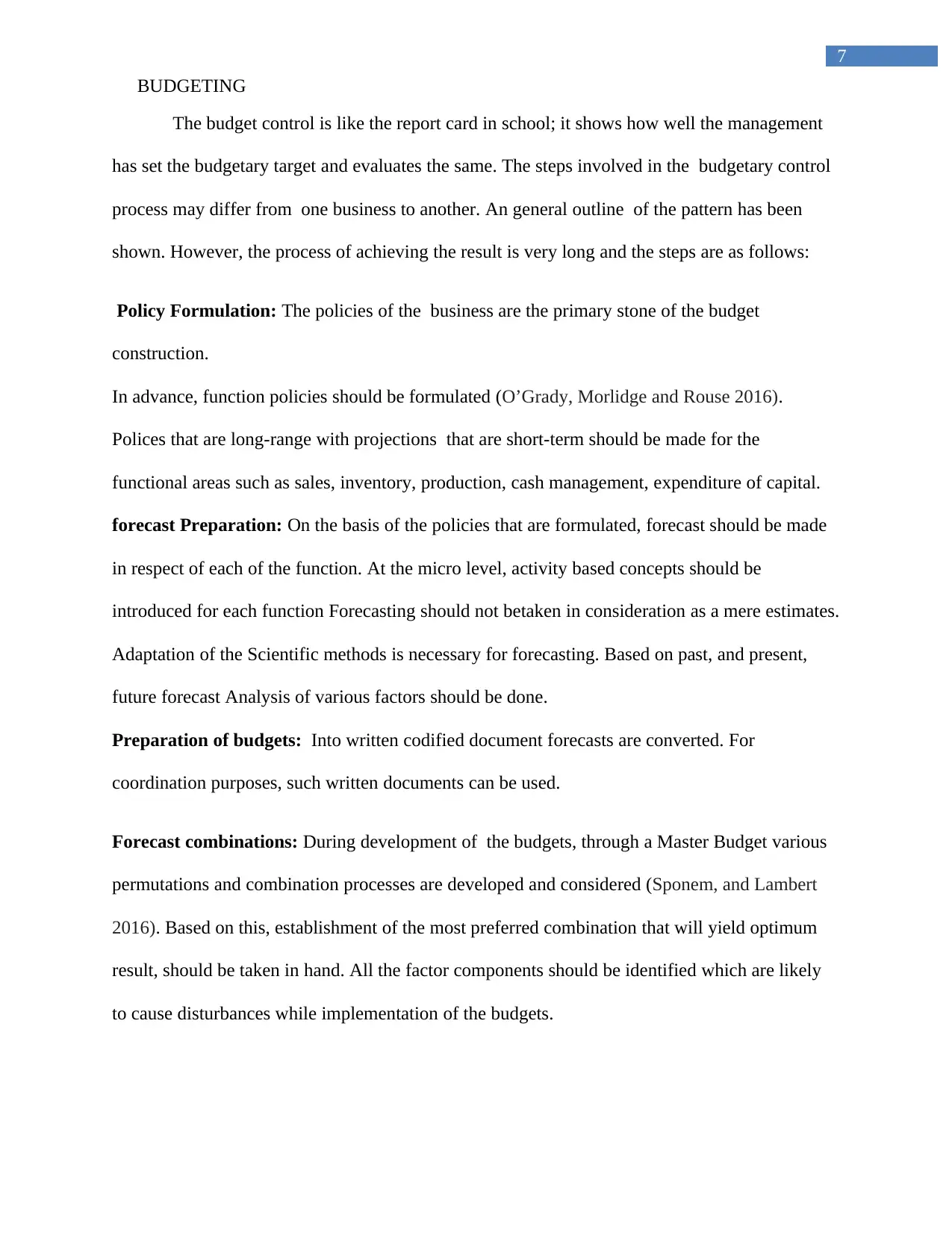
7
BUDGETING
The budget control is like the report card in school; it shows how well the management
has set the budgetary target and evaluates the same. The steps involved in the budgetary control
process may differ from one business to another. An general outline of the pattern has been
shown. However, the process of achieving the result is very long and the steps are as follows:
Policy Formulation: The policies of the business are the primary stone of the budget
construction.
In advance, function policies should be formulated (O’Grady, Morlidge and Rouse 2016).
Polices that are long-range with projections that are short-term should be made for the
functional areas such as sales, inventory, production, cash management, expenditure of capital.
forecast Preparation: On the basis of the policies that are formulated, forecast should be made
in respect of each of the function. At the micro level, activity based concepts should be
introduced for each function Forecasting should not betaken in consideration as a mere estimates.
Adaptation of the Scientific methods is necessary for forecasting. Based on past, and present,
future forecast Analysis of various factors should be done.
Preparation of budgets: Into written codified document forecasts are converted. For
coordination purposes, such written documents can be used.
Forecast combinations: During development of the budgets, through a Master Budget various
permutations and combination processes are developed and considered (Sponem, and Lambert
2016). Based on this, establishment of the most preferred combination that will yield optimum
result, should be taken in hand. All the factor components should be identified which are likely
to cause disturbances while implementation of the budgets.
BUDGETING
The budget control is like the report card in school; it shows how well the management
has set the budgetary target and evaluates the same. The steps involved in the budgetary control
process may differ from one business to another. An general outline of the pattern has been
shown. However, the process of achieving the result is very long and the steps are as follows:
Policy Formulation: The policies of the business are the primary stone of the budget
construction.
In advance, function policies should be formulated (O’Grady, Morlidge and Rouse 2016).
Polices that are long-range with projections that are short-term should be made for the
functional areas such as sales, inventory, production, cash management, expenditure of capital.
forecast Preparation: On the basis of the policies that are formulated, forecast should be made
in respect of each of the function. At the micro level, activity based concepts should be
introduced for each function Forecasting should not betaken in consideration as a mere estimates.
Adaptation of the Scientific methods is necessary for forecasting. Based on past, and present,
future forecast Analysis of various factors should be done.
Preparation of budgets: Into written codified document forecasts are converted. For
coordination purposes, such written documents can be used.
Forecast combinations: During development of the budgets, through a Master Budget various
permutations and combination processes are developed and considered (Sponem, and Lambert
2016). Based on this, establishment of the most preferred combination that will yield optimum
result, should be taken in hand. All the factor components should be identified which are likely
to cause disturbances while implementation of the budgets.
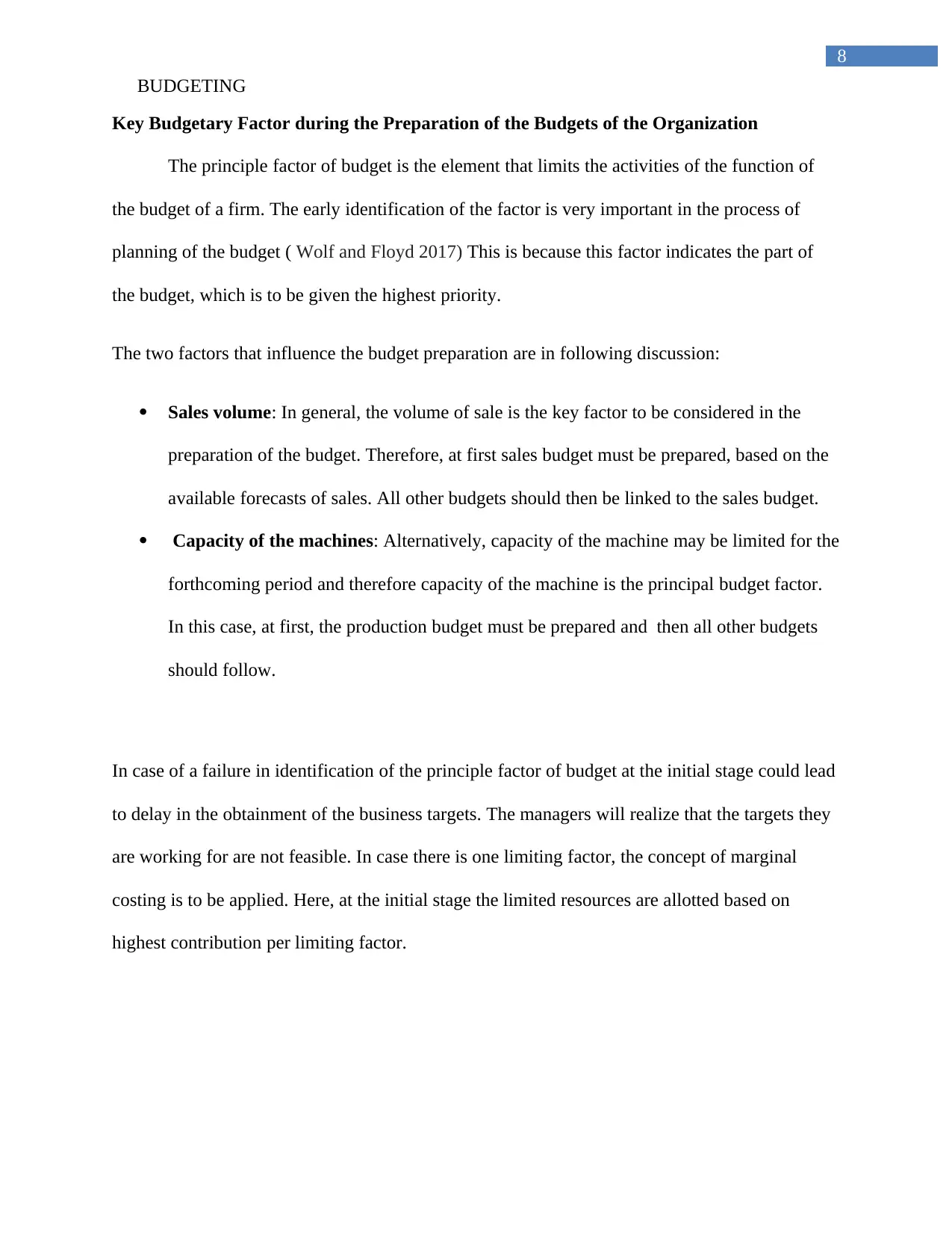
8
BUDGETING
Key Budgetary Factor during the Preparation of the Budgets of the Organization
The principle factor of budget is the element that limits the activities of the function of
the budget of a firm. The early identification of the factor is very important in the process of
planning of the budget ( Wolf and Floyd 2017) This is because this factor indicates the part of
the budget, which is to be given the highest priority.
The two factors that influence the budget preparation are in following discussion:
Sales volume: In general, the volume of sale is the key factor to be considered in the
preparation of the budget. Therefore, at first sales budget must be prepared, based on the
available forecasts of sales. All other budgets should then be linked to the sales budget.
Capacity of the machines: Alternatively, capacity of the machine may be limited for the
forthcoming period and therefore capacity of the machine is the principal budget factor.
In this case, at first, the production budget must be prepared and then all other budgets
should follow.
In case of a failure in identification of the principle factor of budget at the initial stage could lead
to delay in the obtainment of the business targets. The managers will realize that the targets they
are working for are not feasible. In case there is one limiting factor, the concept of marginal
costing is to be applied. Here, at the initial stage the limited resources are allotted based on
highest contribution per limiting factor.
BUDGETING
Key Budgetary Factor during the Preparation of the Budgets of the Organization
The principle factor of budget is the element that limits the activities of the function of
the budget of a firm. The early identification of the factor is very important in the process of
planning of the budget ( Wolf and Floyd 2017) This is because this factor indicates the part of
the budget, which is to be given the highest priority.
The two factors that influence the budget preparation are in following discussion:
Sales volume: In general, the volume of sale is the key factor to be considered in the
preparation of the budget. Therefore, at first sales budget must be prepared, based on the
available forecasts of sales. All other budgets should then be linked to the sales budget.
Capacity of the machines: Alternatively, capacity of the machine may be limited for the
forthcoming period and therefore capacity of the machine is the principal budget factor.
In this case, at first, the production budget must be prepared and then all other budgets
should follow.
In case of a failure in identification of the principle factor of budget at the initial stage could lead
to delay in the obtainment of the business targets. The managers will realize that the targets they
are working for are not feasible. In case there is one limiting factor, the concept of marginal
costing is to be applied. Here, at the initial stage the limited resources are allotted based on
highest contribution per limiting factor.
⊘ This is a preview!⊘
Do you want full access?
Subscribe today to unlock all pages.

Trusted by 1+ million students worldwide
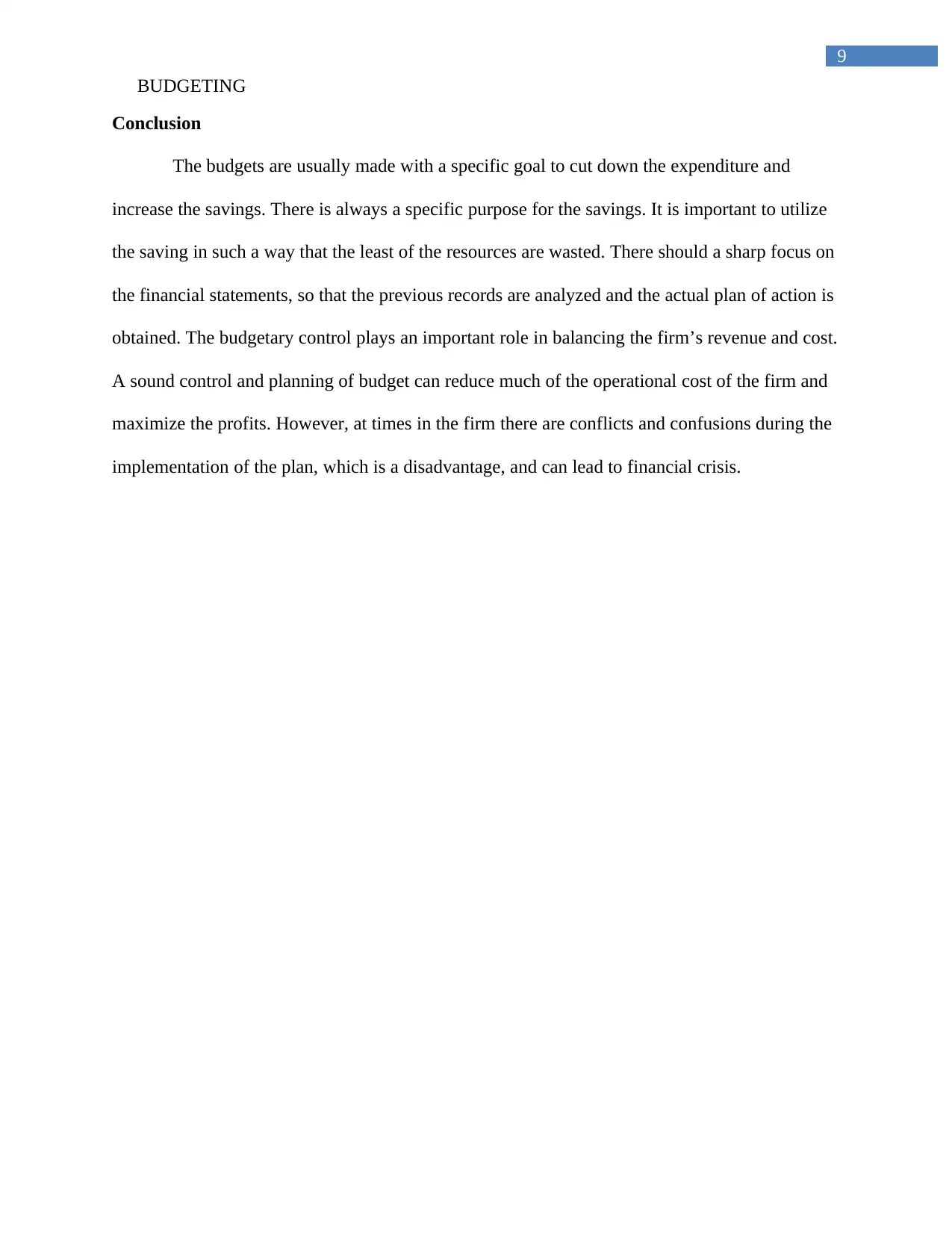
9
BUDGETING
Conclusion
The budgets are usually made with a specific goal to cut down the expenditure and
increase the savings. There is always a specific purpose for the savings. It is important to utilize
the saving in such a way that the least of the resources are wasted. There should a sharp focus on
the financial statements, so that the previous records are analyzed and the actual plan of action is
obtained. The budgetary control plays an important role in balancing the firm’s revenue and cost.
A sound control and planning of budget can reduce much of the operational cost of the firm and
maximize the profits. However, at times in the firm there are conflicts and confusions during the
implementation of the plan, which is a disadvantage, and can lead to financial crisis.
BUDGETING
Conclusion
The budgets are usually made with a specific goal to cut down the expenditure and
increase the savings. There is always a specific purpose for the savings. It is important to utilize
the saving in such a way that the least of the resources are wasted. There should a sharp focus on
the financial statements, so that the previous records are analyzed and the actual plan of action is
obtained. The budgetary control plays an important role in balancing the firm’s revenue and cost.
A sound control and planning of budget can reduce much of the operational cost of the firm and
maximize the profits. However, at times in the firm there are conflicts and confusions during the
implementation of the plan, which is a disadvantage, and can lead to financial crisis.
Paraphrase This Document
Need a fresh take? Get an instant paraphrase of this document with our AI Paraphraser
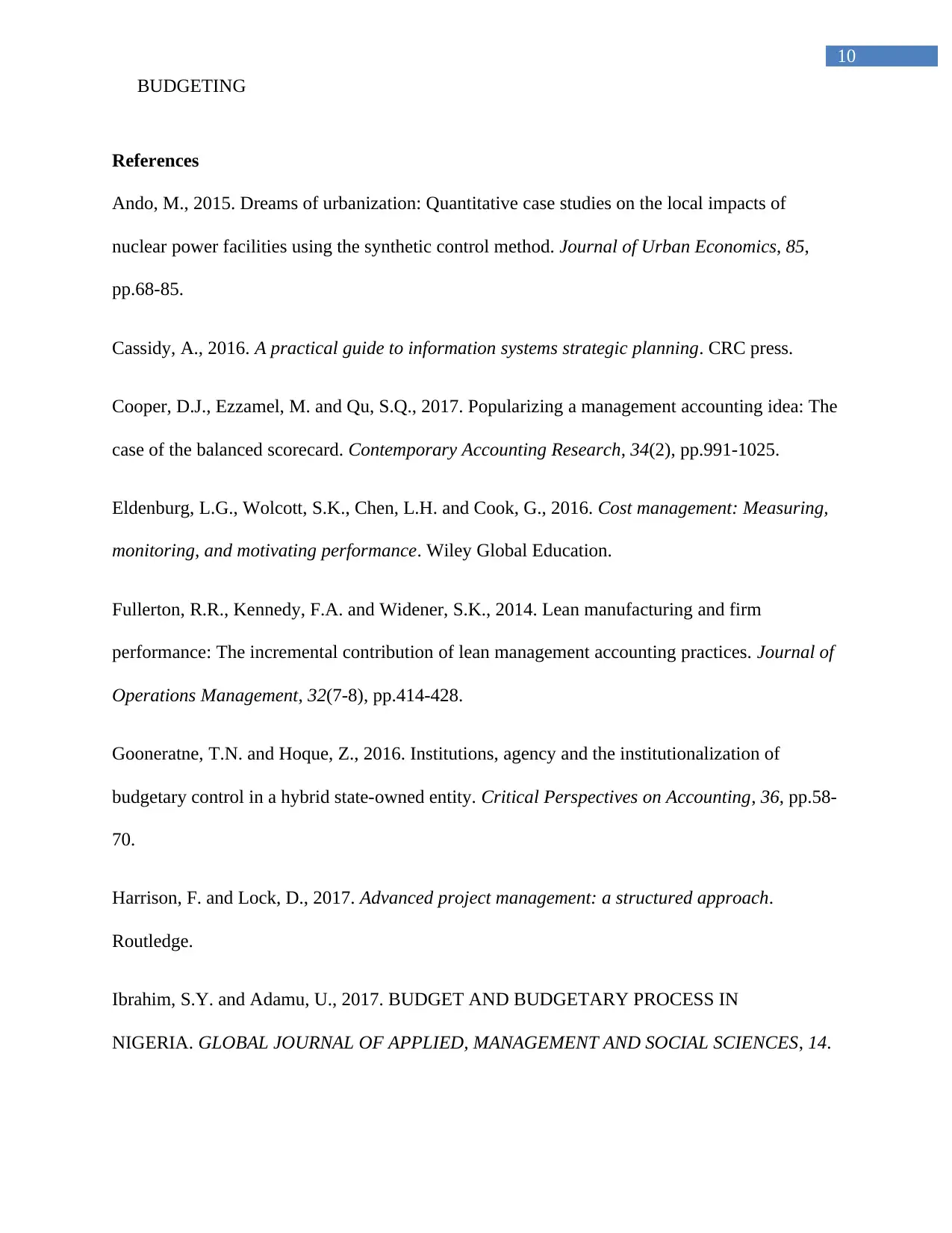
10
BUDGETING
References
Ando, M., 2015. Dreams of urbanization: Quantitative case studies on the local impacts of
nuclear power facilities using the synthetic control method. Journal of Urban Economics, 85,
pp.68-85.
Cassidy, A., 2016. A practical guide to information systems strategic planning. CRC press.
Cooper, D.J., Ezzamel, M. and Qu, S.Q., 2017. Popularizing a management accounting idea: The
case of the balanced scorecard. Contemporary Accounting Research, 34(2), pp.991-1025.
Eldenburg, L.G., Wolcott, S.K., Chen, L.H. and Cook, G., 2016. Cost management: Measuring,
monitoring, and motivating performance. Wiley Global Education.
Fullerton, R.R., Kennedy, F.A. and Widener, S.K., 2014. Lean manufacturing and firm
performance: The incremental contribution of lean management accounting practices. Journal of
Operations Management, 32(7-8), pp.414-428.
Gooneratne, T.N. and Hoque, Z., 2016. Institutions, agency and the institutionalization of
budgetary control in a hybrid state-owned entity. Critical Perspectives on Accounting, 36, pp.58-
70.
Harrison, F. and Lock, D., 2017. Advanced project management: a structured approach.
Routledge.
Ibrahim, S.Y. and Adamu, U., 2017. BUDGET AND BUDGETARY PROCESS IN
NIGERIA. GLOBAL JOURNAL OF APPLIED, MANAGEMENT AND SOCIAL SCIENCES, 14.
BUDGETING
References
Ando, M., 2015. Dreams of urbanization: Quantitative case studies on the local impacts of
nuclear power facilities using the synthetic control method. Journal of Urban Economics, 85,
pp.68-85.
Cassidy, A., 2016. A practical guide to information systems strategic planning. CRC press.
Cooper, D.J., Ezzamel, M. and Qu, S.Q., 2017. Popularizing a management accounting idea: The
case of the balanced scorecard. Contemporary Accounting Research, 34(2), pp.991-1025.
Eldenburg, L.G., Wolcott, S.K., Chen, L.H. and Cook, G., 2016. Cost management: Measuring,
monitoring, and motivating performance. Wiley Global Education.
Fullerton, R.R., Kennedy, F.A. and Widener, S.K., 2014. Lean manufacturing and firm
performance: The incremental contribution of lean management accounting practices. Journal of
Operations Management, 32(7-8), pp.414-428.
Gooneratne, T.N. and Hoque, Z., 2016. Institutions, agency and the institutionalization of
budgetary control in a hybrid state-owned entity. Critical Perspectives on Accounting, 36, pp.58-
70.
Harrison, F. and Lock, D., 2017. Advanced project management: a structured approach.
Routledge.
Ibrahim, S.Y. and Adamu, U., 2017. BUDGET AND BUDGETARY PROCESS IN
NIGERIA. GLOBAL JOURNAL OF APPLIED, MANAGEMENT AND SOCIAL SCIENCES, 14.
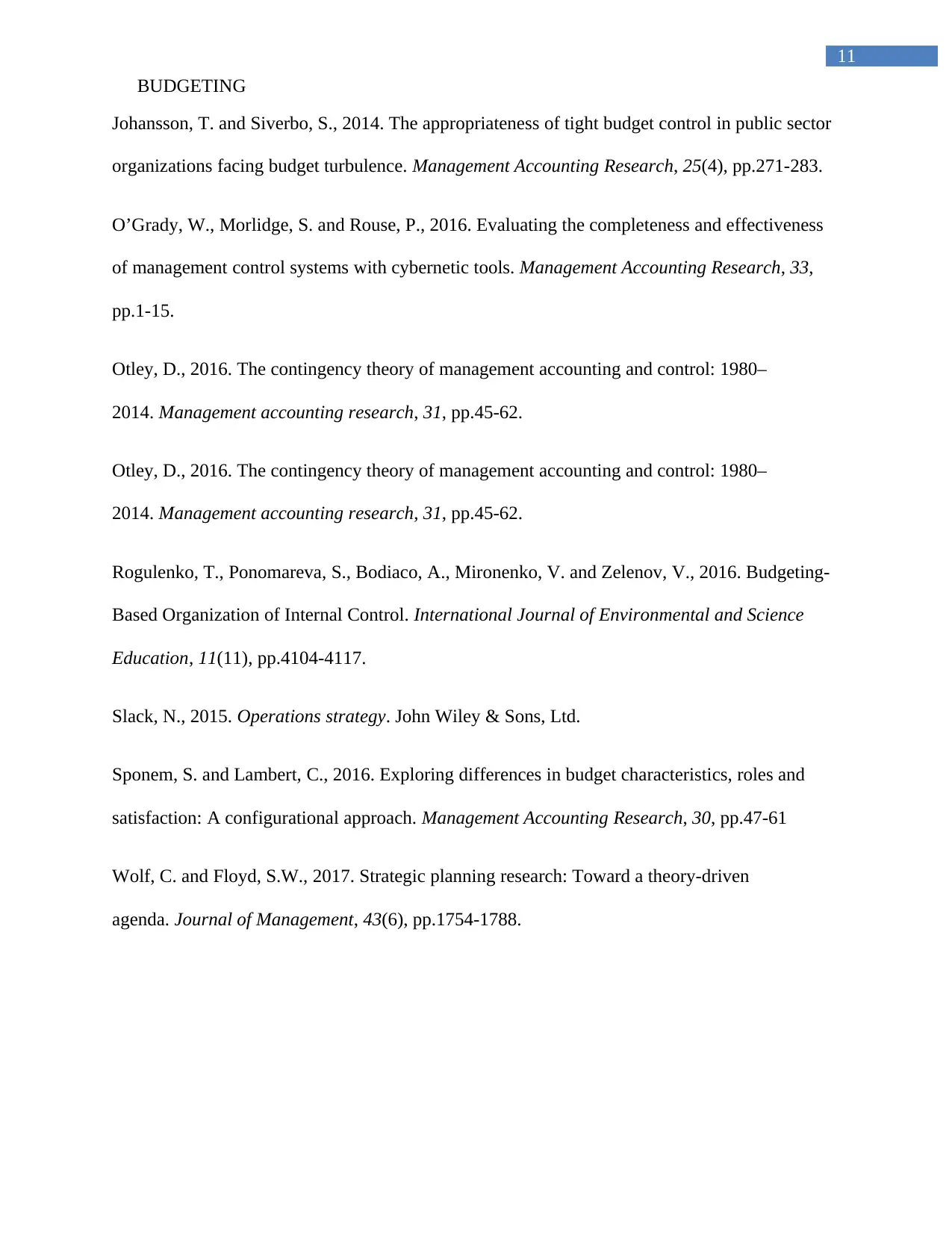
11
BUDGETING
Johansson, T. and Siverbo, S., 2014. The appropriateness of tight budget control in public sector
organizations facing budget turbulence. Management Accounting Research, 25(4), pp.271-283.
O’Grady, W., Morlidge, S. and Rouse, P., 2016. Evaluating the completeness and effectiveness
of management control systems with cybernetic tools. Management Accounting Research, 33,
pp.1-15.
Otley, D., 2016. The contingency theory of management accounting and control: 1980–
2014. Management accounting research, 31, pp.45-62.
Otley, D., 2016. The contingency theory of management accounting and control: 1980–
2014. Management accounting research, 31, pp.45-62.
Rogulenko, T., Ponomareva, S., Bodiaco, A., Mironenko, V. and Zelenov, V., 2016. Budgeting-
Based Organization of Internal Control. International Journal of Environmental and Science
Education, 11(11), pp.4104-4117.
Slack, N., 2015. Operations strategy. John Wiley & Sons, Ltd.
Sponem, S. and Lambert, C., 2016. Exploring differences in budget characteristics, roles and
satisfaction: A configurational approach. Management Accounting Research, 30, pp.47-61
Wolf, C. and Floyd, S.W., 2017. Strategic planning research: Toward a theory-driven
agenda. Journal of Management, 43(6), pp.1754-1788.
BUDGETING
Johansson, T. and Siverbo, S., 2014. The appropriateness of tight budget control in public sector
organizations facing budget turbulence. Management Accounting Research, 25(4), pp.271-283.
O’Grady, W., Morlidge, S. and Rouse, P., 2016. Evaluating the completeness and effectiveness
of management control systems with cybernetic tools. Management Accounting Research, 33,
pp.1-15.
Otley, D., 2016. The contingency theory of management accounting and control: 1980–
2014. Management accounting research, 31, pp.45-62.
Otley, D., 2016. The contingency theory of management accounting and control: 1980–
2014. Management accounting research, 31, pp.45-62.
Rogulenko, T., Ponomareva, S., Bodiaco, A., Mironenko, V. and Zelenov, V., 2016. Budgeting-
Based Organization of Internal Control. International Journal of Environmental and Science
Education, 11(11), pp.4104-4117.
Slack, N., 2015. Operations strategy. John Wiley & Sons, Ltd.
Sponem, S. and Lambert, C., 2016. Exploring differences in budget characteristics, roles and
satisfaction: A configurational approach. Management Accounting Research, 30, pp.47-61
Wolf, C. and Floyd, S.W., 2017. Strategic planning research: Toward a theory-driven
agenda. Journal of Management, 43(6), pp.1754-1788.
⊘ This is a preview!⊘
Do you want full access?
Subscribe today to unlock all pages.

Trusted by 1+ million students worldwide
1 out of 12
Related Documents
Your All-in-One AI-Powered Toolkit for Academic Success.
+13062052269
info@desklib.com
Available 24*7 on WhatsApp / Email
![[object Object]](/_next/static/media/star-bottom.7253800d.svg)
Unlock your academic potential
Copyright © 2020–2025 A2Z Services. All Rights Reserved. Developed and managed by ZUCOL.





